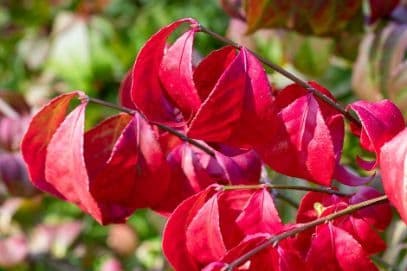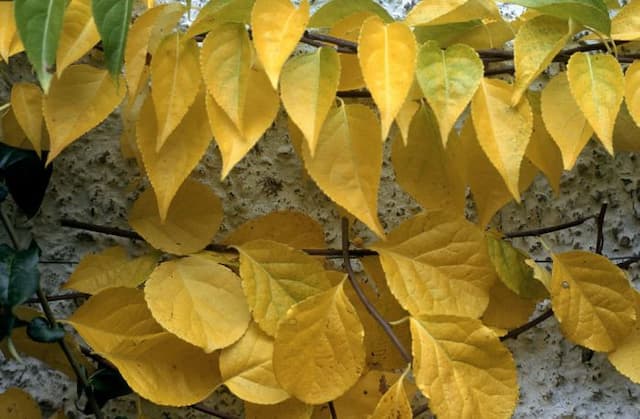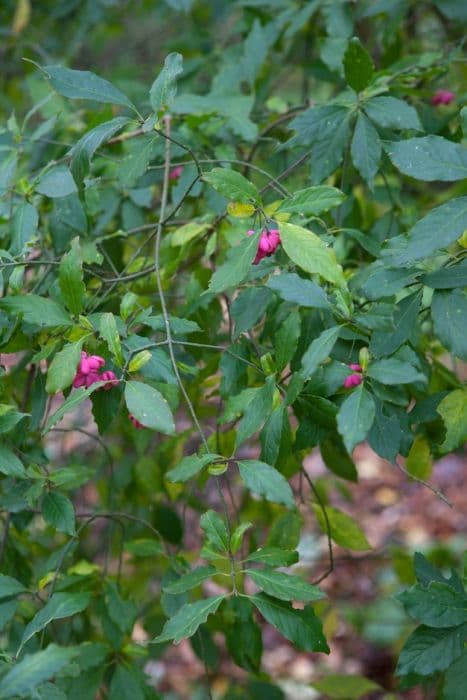Oriental Bittersweet Celastrus orbiculatus Hermaphrodite Group

ABOUT
The plant in question, commonly known as Oriental bittersweet, is a woody vine with a substantial and robust appearance. The leaves are broad, glossy, and round to oval-shaped, often coming to a point at the tip. They are arranged alternately along the vine and turn yellow in the fall. Small, inconspicuous flowers with a light green or yellowish color bloom in the late spring to early summer. These flowers are unique in that they consist of both male and female parts on the same plant, hence the "Hermaphrodite Group" in its name. The attraction of Oriental bittersweet is not just in its foliage and flowers but also in its fruit. After pollination, the vine produces small round fruits which initially appear green but ripen to a yellow-orange hue. These fruits split open to reveal bright red seeds, which stand out vividly against the vine and provide a striking visual during late fall and into winter. The fruits are often used for ornamental purposes. The vine's stem is woody and can be quite strong, with older vines exhibiting a rugged, textured bark. Oriental bittersweet is known for its vigorous growth and its ability to climb and sprawl over other plants and structures. This aggressive tendency can be stunning to look at but also makes the plant a concern in areas where it is considered invasive, as it can outcompete native vegetation.
About this plant
 Names
NamesFamily
Celastraceae.
Synonyms
Oriental Bittersweet, Asian Bittersweet, Round-Leaved Bittersweet, Climbing Spindleberry.
Common names
Celastrus articulatus Thunb., Celastrus articulatus var. orbiculatus (Thunb.) Loes., Celastrus articulatus var. punctatus Loes., Celastrus diacanthus Poir., Celastrus gemmatus Loes., Celastrus hamiltonianus Wall., Celastrus orbiculatus var. orbiculatus, Celastrus punctatus (Thunb.) Roem. & Schult.
 Toxicity
ToxicityTo humans
The most common name for Celastrus orbiculatus Hermaphrodite Group is Oriental bittersweet. It is considered to be toxic to humans if ingested. The ingestion of berries, leaves, or other parts of the Oriental bittersweet can cause symptoms such as vomiting, diarrhea, weakness, and in some cases, seizures or liver damage. It is important to seek medical attention if ingestion is suspected.
To pets
Oriental bittersweet is also toxic to pets. Consuming parts of the plant can lead to symptoms similar to those in humans, including vomiting, diarrhea, abdominal pain, and weakness. In severe cases, ingestion can result in seizures or liver damage. If a pet ingests Oriental bittersweet, it is crucial to contact a veterinarian immediately.
 Characteristics
CharacteristicsLife cycle
Perennials
Foliage type
Deciduous
Color of leaves
Green
Flower color
Greenish-white
Height
30 feet (9.14 meters)
Spread
30 feet (9.14 meters)
Plant type
Climber
Hardiness zones
4-8
Native area
Asia
Benefits
 General Benefits
General Benefits- Habitat for Wildlife: Provides cover and nesting sites for birds and small mammals.
- Erosion Control: Can be used to stabilize soil in areas prone to erosion.
- Aesthetic Appeal: The vines of Oriental bittersweet offer ornamental value with their bright, attractive fruit.
- Shade and Shelter: Creates shaded areas that can lower local temperatures and provide shelter from winds.
- Food Source for Wildlife: The fruits are eaten by various bird species, which can help with seed dispersal.
- Hedge Planting: Can be trained to grow as a hedge, providing privacy and reducing noise pollution.
 Medical Properties
Medical PropertiesThis plant is not used for medical purposes.
 Air-purifying Qualities
Air-purifying QualitiesThis plant is not specifically known for air purifying qualities.
 Other Uses
Other Uses- Celastrus orbiculatus, commonly known as Oriental bittersweet, can be used in floral arrangements and wreath-making due to its brightly colored fruit and attractive fall foliage.
- The plant's vine-like characteristics make it suitable for use in living fences and privacy screens, albeit with careful management to prevent overgrowth and invasiveness.
- Oriental bittersweet's durable and pliable stems have been used in basket-weaving and other traditional crafts.
- The plant can be incorporated into environmental education programs to teach about invasive species and their impact on local ecosystems.
- Some people use the woody vines of Oriental bittersweet as natural materials for creating sculptures and other forms of garden art.
- The fruit capsules, once dried, can be used in potpourri mixes, adding both color and texture.
- Its ability to grow in a variety of soil conditions makes Celastrus orbiculatus a candidate for erosion control, although its invasive nature must be carefully managed.
- Oriental bittersweet might be planted for research purposes to understand the adaptability and competitiveness of invasive species.
- Landscapers may use the plant to quickly cover unsightly structures, provided its growth can be controlled in a non-invasive way.
- Oriental bittersweet's rapid growth can be studied as a model for developing rapid-growing crops or for biomass production in experimental settings.
Interesting Facts
 Feng Shui
Feng ShuiThe Bittersweet is not used in Feng Shui practice.
 Zodiac Sign Compitability
Zodiac Sign CompitabilityThe Bittersweet is not used in astrology practice.
 Plant Symbolism
Plant Symbolism- Invasiveness: Celastrus orbiculatus, commonly known as Oriental bittersweet, is known for its invasive qualities, symbolizing an overwhelming force or something that is hard to control and can take over a given area.
- Resilience: Its ability to grow in a variety of conditions reflects resilience and the idea of thriving against the odds.
- Persistence: Oriental bittersweet's vigorous growth habits represent persistence and the ability to persevere.
- Beauty in adornment: With its attractive berries, Oriental bittersweet is often used in fall wreaths and decorations, symbolizing beauty and the aesthetics of natural ornaments.
 Water
WaterOriental bittersweet should be watered thoroughly, allowing the soil to become moist but not waterlogged. During the growing season, typically spring through summer, watering once a week with about 1 to 2 gallons per plant is adequate. In the absence of rainfall, adjust the frequency to maintain consistent moisture, especially for newly planted vines that require more water to establish. Reduce watering in the fall and water sparingly in winter, as the plant is dormant and requires less moisture during this time.
 Light
LightOriental bittersweet thrives best in full sun to partial shade. The ideal spot for this plant is one where it can receive at least four to six hours of direct sunlight daily. However, it's a versatile plant and can also tolerate lighter shade, although too much shade may reduce its flowering and subsequent fruiting.
 Temperature
TemperatureOriental bittersweet can tolerate a wide range of temperatures, from a minimum of around -20 degrees Fahrenheit to well over 100 degrees Fahrenheit. It grows best in temperate climates where the average temperature is between 60 and 85 degrees Fahrenheit. This hardy vine can survive the cold winters and hot summers typical of many temperate regions.
 Pruning
PruningOriental bittersweet is pruned to control its rampant growth and prevent it from becoming invasive. The best time to prune is during the late winter or early spring before new growth starts. Cut back the vines aggressively to maintain the desired shape and size, and remove any dead, diseased, or tangled branches. Annual pruning is recommended to keep the plant manageable and healthy.
 Cleaning
CleaningAs needed
 Soil
SoilThe best soil mix for Oriental bittersweet is well-draining soil with a pH of 5.5 to 6.5. A blend of garden soil, compost, and perlite or sand works well to promote drainage and fertility.
 Repotting
RepottingOriental bittersweet should be repotted every 2 to 3 years or when it becomes root-bound. Ensure the new pot is slightly larger than the previous one.
 Humidity & Misting
Humidity & MistingOriental bittersweet is tolerant of a wide range of humidity levels but prefers moderate humidity. Average indoor humidity is typically sufficient for this plant.
 Suitable locations
Suitable locationsIndoor
Place Oriental bittersweet in bright, indirect light indoors.
Outdoor
Plant in full sun to partial shade, water regularly.
Hardiness zone
4-8 USDA
 Life cycle
Life cycleCelastrus orbiculatus, commonly known as oriental bittersweet, begins its life cycle when seeds are dispersed by birds or other wildlife, and after overwintering, they germinate in the spring. Seedlings emerge and grow rapidly, using surrounding vegetation for support. The plant undergoes vegetative growth, developing extensive twining vines and forming dense foliage. During late spring to early summer, oriental bittersweet produces small greenish-white flowers in terminal clusters. Being mostly dioecious with the hermaphrodite group having both male and female reproductive structures, these flowers can self-fertilize or cross-pollinate with the help of insects, leading to fruit development. By fall, the plant showcases attractive yellow capsules that open to reveal red fleshy berries, which persist into winter and provide a food source for wildlife, completing the cycle with seed dispersal.
 Propogation
PropogationPropogation time
Spring-Early Summer
Oriental bittersweet is commonly propagated through seed sowing. Mature seeds are collected in the fall after the fruit has ripened to a yellowish color and are sown directly into prepared soil beds or pots. Stratification, which involves simulating natural winter conditions, can enhance germination. Seeds require a period of cold moist stratification for 60-90 days at temperatures of 34-41°F (1-5°C). Ensure the medium does not dry out during this period. After stratification, seeds can be sown in the spring, covering lightly with soil. Germination can be expected once temperatures consistently reach around 68°F (20°C). This method is effective but it should be noted that Oriental bittersweet is an invasive species in some regions, so propagation might be discouraged or regulated.






